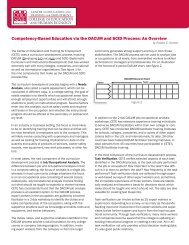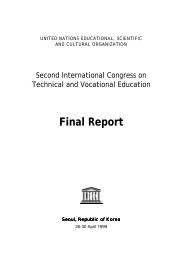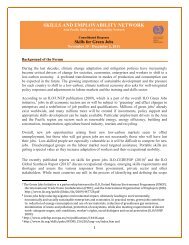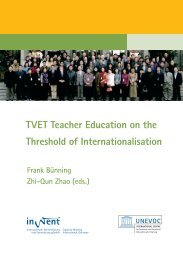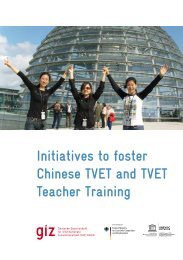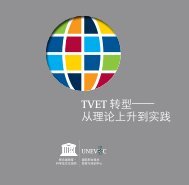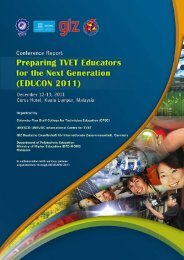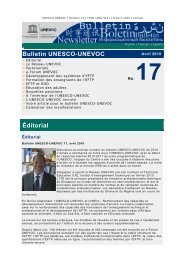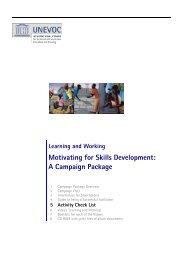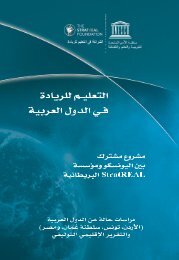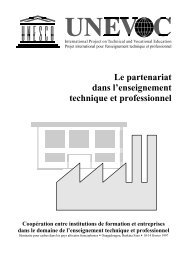Green TVET and Education for Sustainable ... - Unesco-Unevoc
Green TVET and Education for Sustainable ... - Unesco-Unevoc
Green TVET and Education for Sustainable ... - Unesco-Unevoc
You also want an ePaper? Increase the reach of your titles
YUMPU automatically turns print PDFs into web optimized ePapers that Google loves.
sewerage infrastructure, aside from providing the<br />
necessary training materials to the beneciaries.<br />
India<br />
Mr. R. C. Meena, Economic Adviser,<br />
Ministry of Human Resource<br />
Development, in his presentation highlighted that<br />
a rapidly growing population <strong>and</strong> the shortage of<br />
persons with adequate skills are one of the major<br />
issues that India faces in terms of Human Resource<br />
Development. However, it is still crucial <strong>for</strong> the<br />
Indian government to fulll the green re<strong>for</strong>ms in<br />
HRD despite all the challenges.<br />
e approach to the digital age through the adoption<br />
of internet connectivity <strong>and</strong> development of suitable<br />
e-learning materials/ contents to spread digital<br />
literacy is now underway, with a target of increasing<br />
education expenditure to as much as 6% of the GDP<br />
from the present 3.67%, with 1.5% of it alloed in<br />
higher education.<br />
Kenya<br />
Prof. John Simiyu, Ph.D. Centre Team<br />
Leader, in his presentation discussed<br />
the role of the Department of Technology <strong>Education</strong><br />
at Moi University on raising the awareness among<br />
young people about ESD <strong>and</strong> giving them skills<br />
to put sustainable development into practice. It<br />
denes ESD as the “Development of the Curricula<br />
<strong>and</strong> Pedagogy to equip students with the skills<br />
<strong>and</strong> knowledge to live <strong>and</strong> work sustainably aer<br />
they graduate”. Curriculum greening through sta<br />
motivation <strong>and</strong> education on the importance of<br />
<strong>TVET</strong> is also being implemented. It also pointed out<br />
the measures being done to include ESD practices<br />
like prevention of erosion, usage of recyclable<br />
materials <strong>and</strong> environment-friendly instruction<br />
In conclusion, the Department of Technology<br />
<strong>Education</strong> has a potential to integrate ESD practices<br />
in its <strong>TVET</strong> Program while identifying that support is<br />
needed by the sta <strong>and</strong> institution to further enhance<br />
ESD in the <strong>TVET</strong> curriculum,<br />
14 |<br />
Maldives<br />
International Experts Workshop on<br />
<strong>Green</strong> <strong>TVET</strong> <strong>and</strong> <strong>Education</strong> <strong>for</strong> <strong>Sustainable</strong> Development: Capacity Development Needs <strong>for</strong> Water <strong>Education</strong><br />
September 13-17, 2010 | Munich, Germany<br />
Ms. Fathimath Zeena Ali, Assistant<br />
Director, <strong>TVET</strong>, Ministry of Human<br />
Resources, Youth & Sports, in her presentation<br />
pointed out that the rising youth unemployment,<br />
particularly in the regions outside the capital, led to<br />
the initiation of the project called Employment Skills<br />
Training Project (ESTP) developed in collaboration<br />
with the Asian Development Bank to increase the<br />
population’s participation in the labor <strong>for</strong>ce <strong>and</strong><br />
employment.<br />
Major interventions as the Career Path Program<br />
(CPP) <strong>and</strong> the Gulhun (an employment training<br />
program) are being experimented so as to help the<br />
students nd the career that are suited <strong>for</strong> their<br />
acquired skills. Some of the challenges include the<br />
cost of equipment <strong>and</strong> training, the resistance of<br />
some stakeholders to cooperate with the educators,<br />
<strong>and</strong> the unique geographical feature of the country,<br />
which hampers the delivery of crucial services,<br />
including <strong>TVET</strong>. A two-track, dem<strong>and</strong> driven <strong>and</strong><br />
st<strong>and</strong>ards-based <strong>TVET</strong> designed <strong>for</strong> the unique<br />
requirements of the country is being rmly in place,<br />
<strong>and</strong> it is gaining momentum <strong>for</strong> support in its success.<br />
Mongolia<br />
Mr. Natsagdorj Byambasuren, Head<br />
of Agency of <strong>TVET</strong> elucidated that<br />
the <strong>TVET</strong> system in the country is largely guided<br />
by the set of new laws on vocational education <strong>and</strong><br />
training adopted in February 13, 2009. It is based on<br />
the Comprehensive National Development Strategy<br />
<strong>for</strong> the fulllment of the Millennium Development<br />
Goals. ESD practices are being implemented <strong>and</strong><br />
prioritized, with the focus on the mining industry<br />
<strong>and</strong> development.<br />
ey key challenges of this framework are the<br />
development of a responsible mining industry<br />
with the realization of mining deposits through<br />
environmentally sound methods <strong>and</strong> establish<br />
heavy industry sector. It also targets to implement<br />
industrialization policies <strong>and</strong> develop intensied<br />
agriculture, infrastructure <strong>and</strong> governance while<br />
protecting the environment <strong>and</strong> strengthening<br />
human development.



